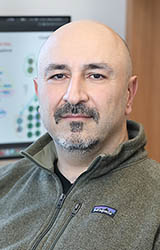Colleagues: Recently Tenured
J. ROBERT HOGG, PH.D., NHLBI
Senior Investigator, Laboratory of Ribonucleoprotein Biochemistry, National Heart, Lung, and Blood Institute

Education: Haverford College, Haverford, Pennsylvania (B.S in biology with a concentration in biochemistry); University of California at Berkeley, Berkeley, California (Ph.D. in molecular and cell biology)
Training: Postdoctoral training, Department of Biochemistry and Molecular Biophysics, Columbia University–Howard Hughes Medical Institute (New York)
Came to NIH: In 2011 as an Earl Stadtman Investigator
Outside interests: Traveling; photography; exploring DC-area restaurants; watching soccer (Sunderland in England, D.C. United in the USA)
Website: https://irp.nih.gov/pi/robert-hogg
Research interests: My lab studies how cells use RNA-protein interactions to regulate gene expression. In particular, my focus has been on quality control: How does a cell distinguish a beneficial messenger RNA (mRNA) from a deleterious one? Our favorite system is the nonsense-mediated mRNA decay pathway, which has the difficult task of determining when an mRNA might encode a truncated, and therefore potentially dangerous, protein.
When I joined the field, a lot of great work identifying proteins that promote mRNA decay had been done. So we decided to do the opposite and look for proteins that can shield specific mRNAs from degradation. We found that two related proteins, polypyrimidine tract-binding protein type 1 (PTBP1) and heterogeneous nuclear ribonucleoprotein L–like protein (hnRNPL), effectively “mark” certain RNAs as beneficial, ensuring that they are not targeted by the RNA-decay machinery.
We think that this mechanism generally allows cells to maintain tight control over gene expression. We were surprised to discover, however, that protection of certain dangerous mRNAs can also promote the development of B-cell lymphoma. These findings have given us a new perspective and toolkit to understand how RNA decay is regulated in human health and disease. (EMBO J 38:pii:e99128, 2019)
ANDREW D. JOHNSON, PH.D., NHLBI
Senior Investigator and Head, Biomedical Informatics, Population Sciences Branch, National Heart, Lung, and Blood Institute; senior investigator, The Framingham Heart Study, NHLBI (Framingham, Massachusetts)

Education: Pennsylvania State University, University Park, Pennsylvania (B.S. in vertebrate physiology); Ohio State University, Columbus, Ohio (Ph.D. in biomedical sciences)
Training: Postdoctoral fellow, Framingham Heart Study, NHLBI
Came to NIH: In 2007 for training; became NHLBI tenure-track investigator in 2012
Outside interests: Spending time with family and friends; doing puzzles; playing boardgames and pinball; juggling; cycling; skiing; playing “old man’s softball”
Website: https://irp.nih.gov/pi/andrew-johnson
Research interests: Platelets are a critical cell type that stops bleeding. Their reactivity, however, is double-edged in that they contribute to cardiovascular disease (heart attacks, clots, and strokes).
My main interests include research on platelet genetics and epidemiology. My laboratory uses population-based approaches to understand how platelets vary across people and whether that variation contributes to disease. I have led the largest studies ever conducted on the genetics of platelet numbers in circulation and how platelets react to stimuli. In these studies my lab found dozens of new genes contributing to platelet variation and cardiovascular disease.
A major goal of the lab is to apply these gene findings to developing potential new drug or lifestyle interventions, or to better personalize antiplatelet treatments in cardiovascular disease. Because smaller studies and basic cell science have suggested that platelets may also play important roles in cancer, diabetes, inflammation, and infectious disease, we also work hard to expand large population studies of platelet measurements to better understand other roles for platelets beyond cardiovascular disease.
VANJA LAZAREVIC, PH.D., NCI-CCR
Senior Investigator, Immunopathogenesis Unit, Experimental Immunology Branch, Center for Cancer Research, National Cancer Institute

Education: University of Nottingham, Nottingham, United Kingdom (B.S. in microbiology); University of Pittsburgh, Pittsburgh (Ph.D. in molecular virology and microbiology)
Training: Postdoctoral fellow in immunology, Harvard School of Public Health (Boston)
Before coming to NIH: Research scientist I, Harvard School of Public Health
Came to NIH: In 2011, tenure-track investigator, Experimental Immunology Branch, NCI
Outside interests: Swimming; traveling; gardening
Website: https://irp.nih.gov/pi/vanja-lazarevic
Research interests: My laboratory is striving to understand how transcription factors and their downstream targets drive the process of autoimmune inflammation in such diseases as multiple sclerosis and rheumatoid arthritis. Dysregulated gene expression due to aberrant activation or inactivation of transcription factors results in the sustained and elevated expression of immune-related genes and leads to chronic inflammation.
In multiple sclerosis, immune cells attack the protective myelin sheath that wraps around neurons in the brain, spinal cord, and optic nerves. Relentless and unchecked immune-system activation in the central nervous system (CNS) leads to irreversible neuronal damage and, ultimately, paralysis. Most of our understanding of the pathogenesis of multiple sclerosis comes from investigations using an experimental autoimmune encephalomyelitis (EAE) mouse model. In this model, both CD4+ T-helper 1 (Th1) and Th17 cells contribute to the pathogenesis of the disease. Our overall goal is to understand how transcription factors and their downstream targets affect CD4+ T-helper cell differentiation and effector function in the context of autoimmune diseases using this EAE animal model.
Our research has yielded new insights into the T-box transcription factor TBX21 (T-bet)–mediated mechanisms that fuel chronic inflammation in the CNS. We have identified cellular pathways that could be targets of future therapeutic interventions in the treatment of immune-mediated disorders. We have demonstrated that the pathogenesis of autoimmune neuroinflammation is dependent on T-bet expression in two immune cell subsets: autoantigen-specific CD4+ T cells and the natural cytotoxicity triggering receptor 1–positive (NKp46+) innate lymphoid cells (ILCs). Targeting T-bet in either subset was sufficient to protect the mice from autoimmunity (Immunity 40:355–366, 2014).
These findings suggest that T-bet-targeted therapies hold great potential in the treatment of CNS autoimmunity. The most significant revelation from these studies was the demonstration that T-bet-dependent NKp46+ ILCs could overthrow the immune-privileged status of the CNS by acting as the gatekeepers to autoreactive CD4+ T cells (Nat Immunol 18:1117–1127, 2017).
Although a growing body of literature is focused on T-cell-specific functions of T-bet in the immune system, our findings exemplify how T-bet expression in the innate immune system is detrimental in the context of autoimmunity. Our study is also the first unequivocal demonstration of the direct involvement of ILCs in organ-specific autoimmunity.
VIJAY RAMCHANDANI, PH.D., NIAAA
Senior Investigator and Chief, Section on Human Psychopharmacology, National Institute on Alcohol Abuse and Alcoholism

Education: K.M. Kundnani College of Pharmacy, Bombay University, Bombay, India (B.Pharm.Sc.); Medical College of Virginia–Virginia Commonwealth, Richmond, Virginia (Ph.D. in pharmacy and pharmaceutics)
Training: Visiting research associate, Department of Medicine/Division of Endocrinology and Metabolism, Indiana University School of Medicine (Indianapolis)
Before coming to NIH: Assistant scientist/assistant professor in the Department of Medicine and associate member of faculty of Indiana University Graduate School, Indiana University (Indianapolis)
Came to NIH: In 2003 as staff scientist; became tenure-track clinical investigator in 2010
Outside interests: Reading; listening to music; cooking
Website: https://irp.nih.gov/pi/vijay-ramchandani
Research interests: My lab studies alcohol-use disorder (AUD), which has a tremendous negative individual and global impact. Research on the clinical pharmacology of alcohol is necessary to explain how variability in alcohol response affects the risk of developing AUD. An improved understanding of the genetic, environmental, and neurobiological factors that affect alcohol response in humans could lead to the development of novel treatments.
We are using behavioral, neuroendocrine, electrophysiological, and functional-imaging measures to characterize the pharmacokinetics and pharmacodynamics of alcohol in humans. These studies, conducted in social and high-risk drinkers, enable the evaluation of genetic and environmental risk factors influencing the acute and adaptive responses to alcohol. We are also conducting studies to develop human laboratory paradigms that can be used to screen novel potential treatments for alcoholism for their ability to alter the pharmacological effects of alcohol and/or alcohol self-administration behavior.
Our lab, in collaboration with a colleague at the Indiana University School of Medicine, developed two pharmacokinetic model–based intravenous alcohol-administration paradigms for human research: 1) the alcohol clamp in which alcohol is administered intravenously and 2) computer-assisted self-infusion of ethanol. Both approaches provide exquisite control of brain-alcohol exposures that overcome the substantial (three- to fourfold) variability in exposures seen after oral alcohol administration. These paradigms provide a unique platform for studies evaluating the influence of risk factors including sex, age, drinking history, and genetic polymorphisms on alcohol responses and alcohol-consumption behavior in human laboratory studies.
We conducted a study—in collaboration with colleagues at the University of Louisville and Robley Rex Veterans Affairs Medical Center (Louisville, Kentucky)—that highlighted the relevance of drinking “too much too fast” as a potential marker of risk for alcohol-use disorder (Am J Psychiatry 174:1094–1101, 2017). We used the intravenous alcohol self-administration paradigm in a sample of nondependent drinkers and demonstrated that the rate of consumption of alcohol was associated with measures of risk for alcohol-use disorder such as sex, family history of alcohol problems, impulsivity, and self-reported sensitivity to alcohol.
SERGIO DAMIÁN ROSENZWEIG, M.D., PH.D., NIH CLINICAL CENTER
Senior Investigator, Department of Laboratory Medicine, NIH Clinical Center

Education: School of Medicine, University of Buenos Aires, Buenos Aires, Argentina (M.D.); University of Buenos Aires (Ph.D. in Immunology)
Training: Residency in Pediatrics, National Pediatric Hospital J. P. Garrahan (Buenos Aires); fellow in Pediatric Immunology, National Pediatric Hospital J.P. Garrahan (Buenos Aires)
Before returning to NIH in 2009: Professor of Pediatrics, Microbiology and Immunology, School of Medicine, University of Buenos Aires
Came to NIH: In April–May 1999, as a guest researcher in the National Institute of Allergy and Infectious Diseases (NIAID); visiting scientist, Clinical Pathophysiology Section in NIAID’s Laboratory of Host Defenses (LHD; 2000–2003); returned in 2009 as head, Infectious Diseases Susceptibility Unit, LHD; and director, NIAID’s Primary Immunodeficiency Clinic; in 2013 became deputy chief of the NIH Clinical Center’s Immunology Service, and chief in 2016.
Outside interests: Playing squash; traveling; following international politics; exploring and tasting ethnic foods
Website: https://irp.nih.gov/pi/sergio-rosenzweig
Research interests: I am a pediatrician and clinical immunologist with more than 25 years of experience in the field of primary immunodeficiency (PID). In our lab, we are studying the molecular and functional aspects underlying PID in people with a genetic susceptibility to mycobacteria and fungal infections (J Allergy Clin Immunol 133:1134–1141, 2014); immune-dysregulation diseases in families with autoimmune or autoinflammatory diseases (J Allergy Clin Immunol 143:1676–1687, 2019); and the role of glycosylation in susceptibility to infectious disease (N Engl J Med 370:1615–1625, 2014).
We are also studying the participation of IKAROS transcription factor family in PID (N Engl J Med 374:1032–1043, 2016). We found that heterozygous mutations in the gene for IKAROS can be involved in the most severe forms of PID such as an autosomal dominant form of common variable immunodeficiency (CVID) that is associated with a striking decrease in B-cell numbers. This latter group of proteins, depending on the type of DNA mutation, can be involved in the most severe forms of PID (i.e., severe combined immunodeficiency or combined immunodeficiency) or the most common symptomatic form of PID (that is, common variable immunodeficiency); carriers of these variants can even be completely asymptomatic. The “how” and “why” this could happen (technically known as penetrance and expressivity of genetic diseases), will keep our lab busy for years to come.
S. CENK SAHINALP, PH.D., NCI-CCR
Senior Investigator, Cancer Data Science Laboratory, Center for Cancer Research, National Cancer Institute

Education: Bilkent University, Ankara, Turkey (B.S. in electrical engineering); University of Maryland, College Park, Maryland (Ph.D. in computer science)
Training: Postdoctoral fellow, Bell Labs (Murray Hill, New Jersey)
Before coming to NIH: Professor and associate chair, Computer Science, Indiana University Bloomington (Bloomington, Indiana); professor and Canada research chair, Simon Fraser University and Vancouver Prostate Centre (Vancouver, British Columbia, Canada)
Came to NIH: In 2019
Outside interests: Biking; playing tennis; skiing; traveling with family
Website: https://irp.nih.gov/pi/s-cenk-sahinalp
Research interests: In my research, I apply combinatorial algorithms to analyze cancer genome data. My lab’s key focus is the discovery and interpretation of large-scale (especially structural) genomic and transcriptomic variants in tumor samples. Our algorithmic methods were the first that had the ability to handle novel insertions, deletions, inversions, and duplications in repetitive regions of the human genome.
In the past 15 years, my lab has produced many algorithmic tools for analyzing high-throughput sequencing data and in particular for discovering and interpreting large-scale genomic structural alterations in tumors. Our tools—such as VariationHunter, novelSeq and DeStruct—were the first algorithmic methods that could handle novel insertions, deletions, inversions, and duplications in human genomes.
My group has developed many other algorithmic and computational methods, including Cypiripi and Aldy, which can identify structurally variant genes such as those involved in drug metabolism. In addition, we contributed to the identification and quantification of transcriptomic aberrations such as gene fusions, genetic inversions, duplications, and deletions in cancer samples.
I have an additional interest in “algorithmic infrastructure” for genomics; this includes mapping (of reads from repetitive regions of the genome or those with high error rates); compressing genomic data; and secure and privacy-preserving computing with genomic data. Our mapping tools, mrFAST and mrsFAST, are among the best for multi-mapping (identifying all mapping loci for a given read). Similarly, our genomic data-compression methods have been leaders in both compression rate and speed. One recent method, called SkSES (Sketching algorithms for Secure Enclave-based genomic data analysis) is the first computational framework to perform secure and privacy-preserving collaborative genomic analysis (bioRxiv, 2018; DOI:10.1101/468355).
This page was last updated on Tuesday, March 29, 2022
